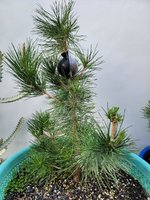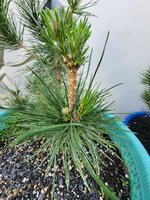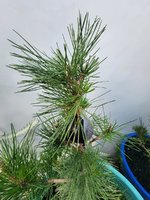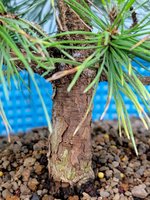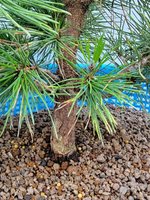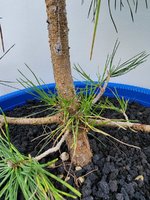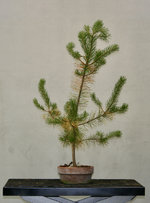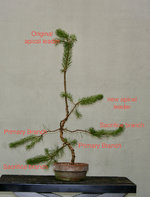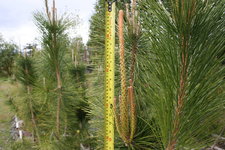bangsaturday
Sapling
Hello Bonsai Nutters,
I am a newbie at Japanese Black Pine. Read a lot of threads by the grand masters here on Bonsainut.com, and have learn vicariously - each and every day.
New information bombarding my brain cells instantaneously, gratification at its very best. Much thanks to those who are willing to share their experiences via prose & photos alike.
JBP is hard work, long at best. It is not a project that can be started and left alone. Every day is an enjoyable challenge.
I say this because I have just started a batch of 100 Senjumaru & Red Pine seeds on 1st April 2022, and am left with about 7 as of today. My mistake: Transplanting way too early, causing damping, and most of the most viable ones perish within a span of a few days.
Got to keep moving on. So I have started another batch of JBPs & Red Pines on a bed of Akadama & Kiryuzuna pumice in a flatbed colander, and sprouts have emerged exactly 10 days from planting.
Flashback
2020 was the year I decided to acquire young JBPs, around 6 months to 1 year olds, around 20cm tall to 50cm.
I had no idea what I was getting. I purchased the following JBPs based on digital photos that was posted online.
H E L P !
Fast forward to about 2.5 years later, I have around 5 JBPs that have grown taller but I have no idea what type they are.
So I need the expertise of fellow nutters on identifying these JBPs.
Progression Advice
This is important. I have not done anything to these JBPs with the exception of repotting them in March 2022 to bigger colanders (30/30/30 mix of Akadama, Pumice & Lava rock)
I had intended to grow them Telperion Black Pines style on a plot of land several hundred metres above sea level here on Bali, and keep just 1 or 2 to focus on Bonsai styling.
With the exception of 1 JBP, the rest have been left on their own devices to grow initially in a 50/50 mix of black coarse sand & bamboo humus.
All JBPs have been on a 17-10-11 Osmocote slow release regime.
What should I do now? Any advice will be great. Honesty I can take, criticisms more than welcomed. I have only about 1.5 months before I need to fly off for work. So these JBPs will continue to left to their own devices once again.
Thank you in advance guys! Appreciate any prose of any length....
JBP # 1

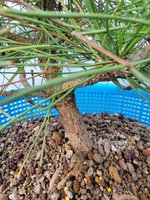

I am a newbie at Japanese Black Pine. Read a lot of threads by the grand masters here on Bonsainut.com, and have learn vicariously - each and every day.
New information bombarding my brain cells instantaneously, gratification at its very best. Much thanks to those who are willing to share their experiences via prose & photos alike.
JBP is hard work, long at best. It is not a project that can be started and left alone. Every day is an enjoyable challenge.
I say this because I have just started a batch of 100 Senjumaru & Red Pine seeds on 1st April 2022, and am left with about 7 as of today. My mistake: Transplanting way too early, causing damping, and most of the most viable ones perish within a span of a few days.
Got to keep moving on. So I have started another batch of JBPs & Red Pines on a bed of Akadama & Kiryuzuna pumice in a flatbed colander, and sprouts have emerged exactly 10 days from planting.
Flashback
2020 was the year I decided to acquire young JBPs, around 6 months to 1 year olds, around 20cm tall to 50cm.
I had no idea what I was getting. I purchased the following JBPs based on digital photos that was posted online.
H E L P !
Fast forward to about 2.5 years later, I have around 5 JBPs that have grown taller but I have no idea what type they are.
So I need the expertise of fellow nutters on identifying these JBPs.
Progression Advice
This is important. I have not done anything to these JBPs with the exception of repotting them in March 2022 to bigger colanders (30/30/30 mix of Akadama, Pumice & Lava rock)
I had intended to grow them Telperion Black Pines style on a plot of land several hundred metres above sea level here on Bali, and keep just 1 or 2 to focus on Bonsai styling.
With the exception of 1 JBP, the rest have been left on their own devices to grow initially in a 50/50 mix of black coarse sand & bamboo humus.
All JBPs have been on a 17-10-11 Osmocote slow release regime.
What should I do now? Any advice will be great. Honesty I can take, criticisms more than welcomed. I have only about 1.5 months before I need to fly off for work. So these JBPs will continue to left to their own devices once again.
Thank you in advance guys! Appreciate any prose of any length....
JBP # 1











